Would you like to improve your recruitment process? Do you struggle to find the best candidates for your open positions? Are you wasting valuable time and resources on the recruitment process? If so, read on. In this blog post, we will discuss how to streamline your recruitment process and find the best candidates for your organization. We will also provide tips and advice on how to improve your recruitment strategy. So, let’s get started!
What Are Candidates per Hire?
Candidates per Hire is the number of candidates who applied for a role divided by the number of hires made from that role. This metric can be used to evaluate the efficacy of your recruitment efforts, as well as predict how many candidates should be in your pipeline in order to make a successful hire for a similar role. It can also provide insight into how well your marketing strategies are performing, and give you an idea of the overall candidate experience.
A high Candidates per Hire ratio indicates that the company is not effectively converting applicants into hires or that the applying pool is not qualified. In order to decrease this number, companies should focus on creating targeted campaigns that attract higher-quality candidates and improve their candidate experience to increase conversion rates.
Why Is It Important For Startups To Track This Metric?
Tracking candidates per hire is important for startups because it provides insight into the effectiveness of their recruitment process. By tracking each candidate’s progress throughout the hiring process, startups can identify areas where they can improve their recruiting efforts and tailor the selection process to better suit their needs. This can be especially useful in an era where talent competition is fierce, as it allows startups to understand better their own strengths and weaknesses in the recruitment process. Additionally, tracking candidates per hire can provide valuable data points that can help businesses to make more informed decisions when considering new hires.
How do you Calculate Candidates per Hire?
Here is the formula:
Total # candidates / Total # hires = Candidates per Hire
To calculate Candidates per Hire, divide the total number of candidates by the total number of hires. This number is especially useful for pipeline predictions. You may want to segment the total candidate number to a particular role or level for a more accurate number. For example, if you’re calculating Candidates per Hire for entry-level positions, you would only use the candidate information and hire data for entry-level positions. The Candidates per Hire ratio will help you understand how many candidates you need to interview in order to make one hire. If your goal is to reduce time-to-hire, then you’ll want to lower your Candidates per Hire ratio.
Different Ways of calculating candidates per hire
For the most accurate results, we advise that you start by working out your overall Applicants to Hires ratio. This number can then be broken down further to measure the efficiency of your recruitment pipeline according to origin, team, and role. By doing this, you will gain valuable insights that can help you to optimize your approach.
A. Calculating overall candidates per hire for your organization (admins only)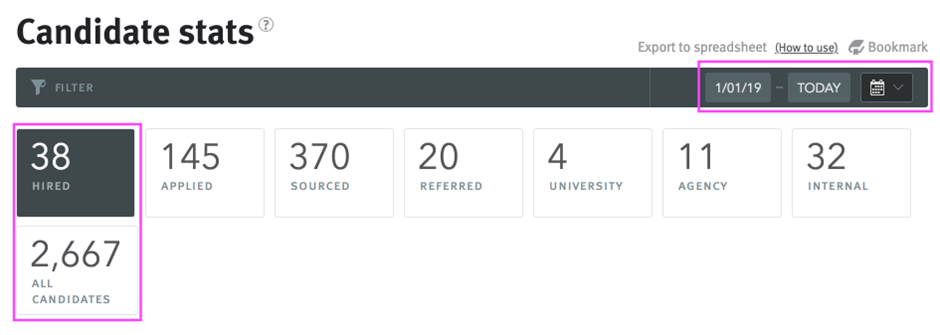
To calculate your overall candidates per hire ratio, simply divide the total number of candidates in your recruitment pipeline by the number of hires made during a specified period. All individuals active in the pipeline at any point during this time frame should be included, including those moved to the archive. For example:
2667 candidates ÷ 38 hires = 70.2 candidates per hire
B. Calculating overall candidates per hire by origin (admins only)
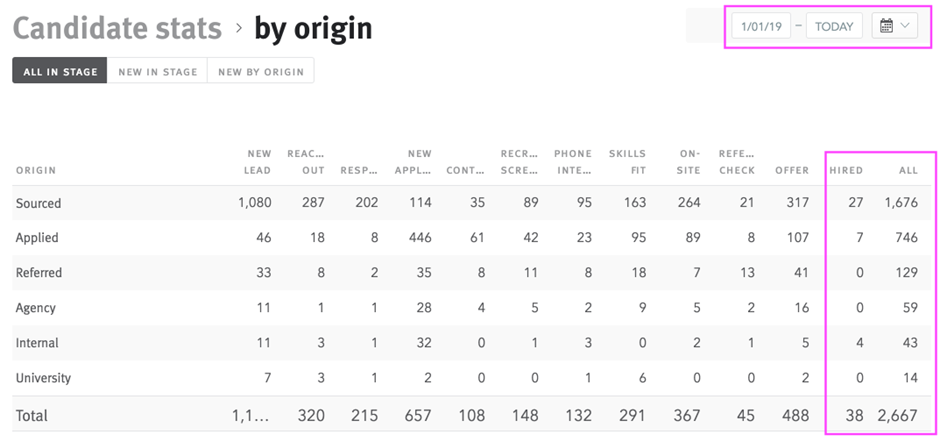
To calculate your ratio of candidates to hires for each origin, divide the total number of candidates from that origin by the number of hires made from the same origin. In the example above: 43 internal candidates ÷ 4 hires = 10.75 candidates per hire
C. Calculating overall candidates per hire by team (admins only)
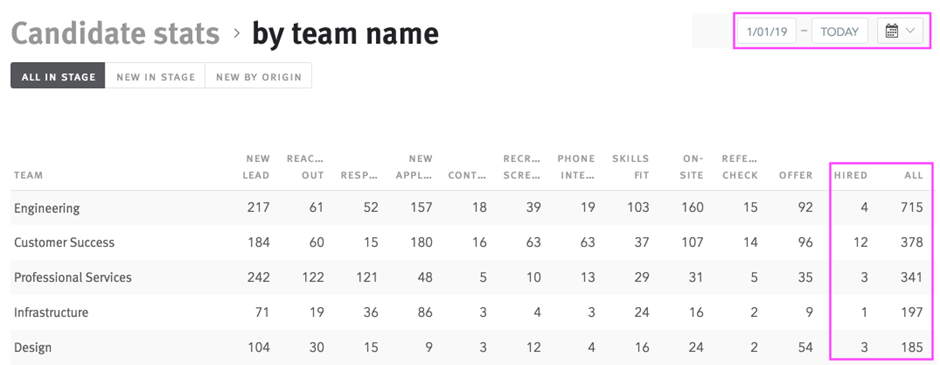
378 Customer Success candidates ÷ 12 hires = 31.5 candidates per hire
D. Calculating overall candidates per hire by job posting (admins and hiring managers)

Navigate to the job posting dashboard for any position you have access to. Scroll down to the “Pipeline Predictions” section and view your candidate-per-hire ratio for that role. This will give you an indication of how many candidates, on average, must be interviewed before a suitable hire is found.
E. Calculating candidates per hire by origin by job posting (admins and hiring managers)
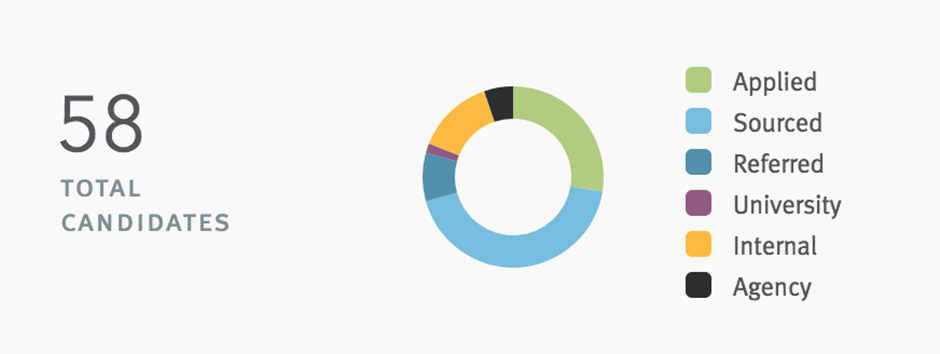
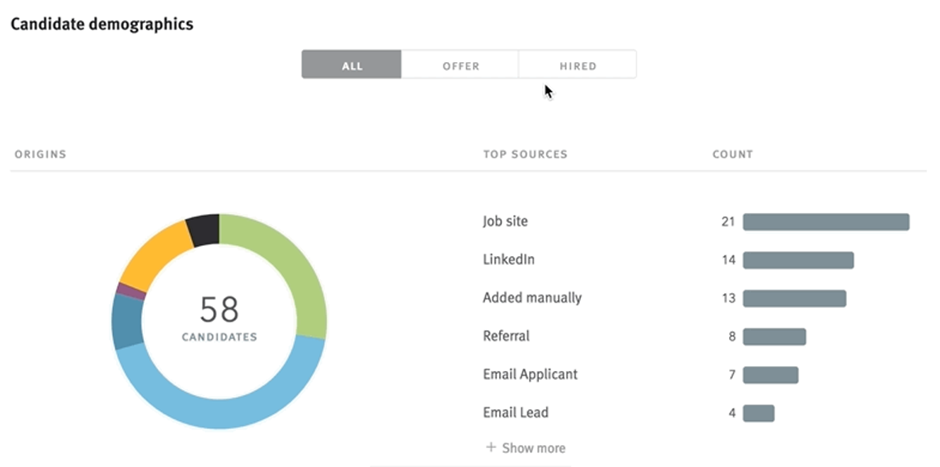
Begin by viewing the job posting dashboard for any active role to which you have access. The summary at the top of the page will display the sources of the applicants for that job. To gain further insight, scroll down to the “Candidate demographics” section and toggle between ‘All’ and ‘Hired’ candidates. For illustration purposes, let’s examine the example above: sourced candidates made up nearly half of the applicants, but all hires were sourced! Examining these statistics can provide valuable insight into which sources are most successful for a given role.
What factors affect Candidates per Hire?
Here are some factors that affect candidates per hire:
Quality of job description
A well-written and clear job description can help attract the right kind of candidate for the open position. An effective job description should include all necessary information about the responsibilities, requirements, qualifications and other important details about the position.
Job boards
The quality and reach of job postings on different job boards can have a significant effect on the number of candidates applying for a particular position. Using job boards with large amounts of traffic and targeting specific locations, industries, or skills can help increase the amount of applicants you receive.
Recruiting sources
The sources used to recruit potential candidates also have an impact on the number of applicants. Utilizing a variety of sources, such as referrals, social media networks and industry-specific job fairs will help to find the most qualified candidates for the position being filled.
Location
The location of the position can have an effect on candidate per hire. If the company is located in a city with a large population or a particular industry hub, then it is likely to receive more applications than a position located in a rural area.
Compensation
The salary and benefits offered for the position can affect how many candidates apply for the role. Offering competitive compensation packages that are well-aligned with market rates will help attract more qualified applicants for the open position.
Timing
The time of year when hiring is taking place can have an impact on the number of candidates per hire as well. During times of high unemployment, more candidates are likely to be available for positions than when the job market is tight.
Company reputation
Factors such as a company’s reputation and its workplace environment can also have a major effect on candidate per hire. A positive reputation and enjoyable work culture will often lead to more qualified candidates applying for the position.
Hiring process:
The length and complexity of the hiring process can also affect how many applicants are willing to go through it. Streamlining the hiring process and reducing the amount of paperwork and bureaucracy can help to increase the number of candidates.
All of these factors can have an impact on the final amount of candidates per hire, so it is important for companies to consider them when planning their hiring strategy. By taking the time to understand each factor, employers can make sure they get the best possible applicants for their open positions.
What are the effects of Candidates per Hire on a startup
Here are some effects of Candidates per Hire on a startup:
Cost
Candidates per Hire affects the cost of managing a startup. A high number of candidates per hire can lead to an increase in recruitment costs as well as training costs for onboarding new employees.
Quality
The quality of employees recruited by a startup is largely dependent on the quality of candidates that are sourced. A high number of candidates per hire can have a direct effect on the quality of employees that are recruited.
Time
The time taken to recruit suitable candidates is also an important factor. If too many irrelevant or unsuitable applications are received, it can take more time to find the right person for the job and thus affect the overall efficiency and effectiveness of the recruitment process.
Employee Retention
Having a high number of candidates per hire can also affect employee retention as it may be difficult to find the right person for the job and thus lead to higher employee turnover rates.
Brand Image
A startup’s brand image is affected by the quality of candidates that are sourced. If the quality is not up to par, it can affect the overall perception of a startup’s brand and may lead to negative feedback from prospective employees.
Overall, Candidates per Hire have an effect on the success of a startup and should be carefully considered when recruiting new staff. It is important to ensure that the recruitment process is efficient and cost-effective, while also finding suitable candidates for the job in a timely manner. In addition, it is important to ensure that the quality of talent sourced is high in order to maintain an excellent brand image.
What is a Good Candidates per Hire?
A good candidate per hire is one who has the right skills and knowledge to be successful in the job. The ideal candidate should have the necessary technical and professional qualifications needed for the position, as well as strong interpersonal skills. These include a positive attitude, good communication, problem-solving abilities and the ability to work well with others.
Additionally, they should be able to perform their duties and responsibilities with minimal supervision, keep up-to-date with new technologies, and meet deadlines. They should also be capable of adapting to a changing work environment and being flexible in order to meet the needs of the organization. Finally, a good candidate should also have the potential to grow and develop within the company.
How to compare candidates per hire to the industry average?
Having an understanding of your own numbers is a great starting point. Lever’s newly updated 2019 Benchmarks Report helps you compare against other companies, based on size, department/team, and role. This allows you to see how your company is performing in comparison to your competition. With the report, you can always have a clear understanding of how your company is faring relative to others. For example, a company having 214 employees will find these statistics relevant:
For companies sized 101-500 employees:
- Overall candidates per hire: 74 candidates (p. 34)
- Sourced candidates per hire: 34 candidates (p. 34)
- Applied candidates per hire: 119 candidates (p. 34)
- Candidates per hire for engineering roles: 113 candidates (p. 36)
- Candidates per hire for customer service roles: 34 candidates (p. 36)
What are tips to improve candidates per hire?
Here are some best tips to improve candidate per hire:
Make sure job descriptions are clear and accurate
Before posting an ad, recruiters should review the job description to ensure it accurately reflects the position’s duties and responsibilities. This helps potential candidates better understand what is expected of them and increases the chances they will apply for the role if it is a good fit.
Utilize recruitment software
Recruitment software can be a great tool for streamlining the recruitment process and improving the number of qualified candidates per hire. Automation tools can help recruiters quickly source and organize applicants, leaving more time to focus on interviewing and selecting the best candidate for the job.
Leverage employee referrals
Employee referrals are an effective way to increase the quality of applicants for a job opening. Encouraging existing employees to refer their contacts can also bring in higher-quality candidates and reduce time spent reviewing applications since the employee already knows the referred candidate’s skillset and qualifications.
Post jobs on multiple platforms
To reach as many potential applicants as possible, recruiters should post job openings on multiple platforms. This could include job boards, social media, professional networks and more.
Offer competitive salaries
Offering a competitive salary is an important step in attracting top talent for open positions. Candidates can easily compare salaries across different companies when researching available jobs and will likely choose the most lucrative option.
Reach out to passive candidates
Reaching out to passive job seekers is another way to increase the number of qualified applicants for a role. These are candidates who aren’t actively searching for a job but may be interested in an opportunity that aligns with their career goals and experience. Recruiters can reach out to these passive applicants through targeted marketing or by connecting with them on professional networks.
Create a great candidate experience
The entire recruitment process should be designed to give candidates the best possible experience, from their initial interactions with recruiters to post-interview follow-up. Every interaction should leave a lasting impression and make candidates feel valued and appreciated. This can help build relationships with potential hires, which can lead to higher-quality applicants in the future.
Track recruitment metrics
Regularly tracking and analyzing recruitment metrics, such as time-to-hire and cost-per-hire, can help recruiters identify areas for improvement and better understand why some positions are harder to fill than others. This can help recruiters adjust their strategy and increase the number of qualified candidates being hired.
Consider hiring from within
When a position becomes available, it’s worth considering existing employees for the role if they have the necessary skills and qualifications. This reduces recruitment costs since no external sources need to be used, and it also rewards existing employees for their loyalty and dedication.
Take a targeted approach to interviews
When interviewing potential candidates, recruiters should take a targeted approach to ensure they are finding the right person for the job. This means asking clear questions that specifically relate to the position and using assessments to evaluate the applicant’s skills and abilities. Doing this will help ensure the best candidate is chosen for the role.

